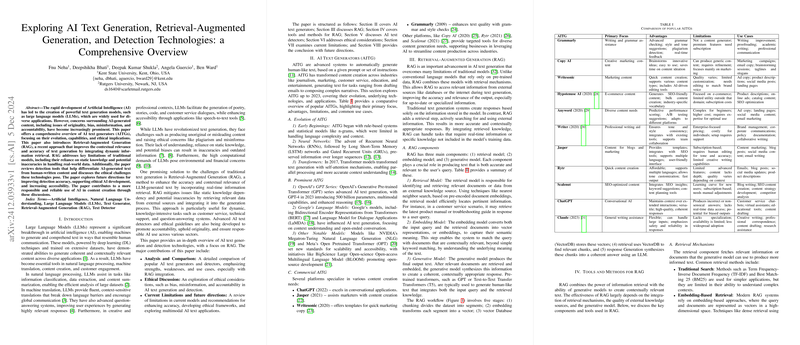An Overview of AI Text Generation, Retrieval-Augmented Generation, and Detection Technologies
The paper "Exploring AI Text Generation, Retrieval-Augmented Generation, and Detection Technologies: a Comprehensive Overview" authored by Neha et al. presents a meticulous examination of current advancements in AI text generation technologies, particularly focusing on LLMs and Retrieval-Augmented Generation (RAG), alongside tools designed for detecting AI-generated text. It emphasizes the capabilities, limitations, and ethical considerations relevant to these technologies.
The paper investigates AI Text Generators (AITGs) that leverage LLMs, documenting their evolution from rule-based systems to present-day transformer-based architectures. These models, such as OpenAI's GPT series and Google's LaMDA, have furthered AI's utility in fields like journalism, customer service, and creative writing. Notably, the paper references the significant parameter growth in these models, exemplified by GPT-4's 500 billion parameters, revealing an ongoing trend toward more sophisticated, multi-modal capabilities.
A central theme of this paper is the Retrieval-Augmented Generation (RAG) approach, which represents a significant shift from traditional static text generation to models that dynamically incorporate external information retrieval. This method significantly enhances text relevance and accuracy, particularly in knowledge-intensive applications such as technical support and interactive question-answering systems. The RAG paradigm is especially pertinent in addressing the static knowledge limitation of conventional LLMs by real-time information integration through robust retrieval mechanisms.
An essential component of the paper is its critical discourse on the detection of AI-generated text, exploring the technological solutions and ethical implications therein. AI Text Detector (AITD) systems such as GPTZero, Turnitin, GLTR, among others, are analyzed in terms of their detection accuracy and capacity to address issues such as academic plagiarism and content authenticity. The examination extends to the comparative analysis of these detection tools, highlighting their methodological strengths and limitations.
The ethical discourse surrounding AITGs, RAG systems, and AITDs is crucial, particularly concerning biases in training data, misinformation risks, privacy, intellectual property, and accountability. The authors argue that despite advancements in these technologies, enthusiasm must be tempered by robust ethical frameworks to prevent unintended consequences such as data bias amplification or IP rights infringement. A holistic approach incorporating bias detection, inclusive datasets, and transparent accountability measures is recommended.
The paper concludes by delineating current technological limitations, including data dependency, potential model hallucinations, and significant computational resource demands—critical considerations for the scalability and environmental impact of these technologies.
Further exploration and advancements in RAG, AI text generation, and detection technologies should aim at not only improving their technical capabilities but also enhancing their psychological and social integration. As AI's role in content creation expands, its responsible use will demand attentive alignment between technological evolution and socio-ethical obligations.
